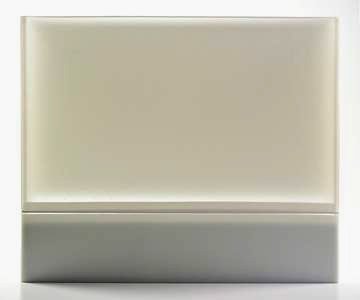GLASS QUARTERLY
Review:
Jessica Loughlin
at Bullseye Gallery (Portland, Oregon)
by Richard Speer
Australian artist Jessica Loughlin hones in on the horizontal in her exhibition, "Shifting Views," finding nuance and mystery in that hard, eternal line. In doing so, she situates herself on the long timeline of artists who have looked to their particular horizons as starting points. Among abstract artists, one thinks most archetypically of Piet Mondrian, whose reductivism germinated in the flat Dutch landscape, delineated from the horizon by the ever-present North Sea. In similar topographic fashion, Loughlin's works in kiln-formed glass arise intrinsically from the vast open plains and unforgiving Outback of her native country. It was, in fact, the experience of flying over these landscapes that led her to her current body of work. "Staring out my plane window," she writes in her artist's statement, "I watched marks on the earth created by dirt roads... I felt their distance... I felt my distance away from the land." Then, when clouds obscured her view, she was left with "only white outside, and the dark spots on the inside of my eyes."It is telling that these works take such explicit inspiration from phosphenes (the luminous impressions the retina "sees" after we turn away from the sun or bright lights), for phosphenes are both real and unreal, visible yet mirage-like. They derive from real objects but exist a step removed from their referents. With these haunting effects, then, literally in her mind's eye, Loughlin has set about communicating truths that hide somewhere "between two spaces, between what is seen and what is felt." That she accomplishes this goal without recourse to easy melodrama, but rather with an elegance that feels inevitable, is the most significant achievement of the "Shifting Views" exhibition. Loughlin succeeds in capturing a spatial, almost kinesthetic, ambiance in a manner that is simple but not simplistic.
From afar the works appear monolithic, like great wedges of color field, but upon closer inspection are varied in both production and effect. Myriad bubbles suspended inside clear and opaque glass in works such as Space Between 10/05 suggest eddies beneath a brook's surface, froth within smoothness, as if gasses and liquid were frozen a split-second before coalescence. Some works seem to pile slices of sky upon one another in layers: cloud strata upon cold fronts upon sunset hues, the lines separating each layer diffused as if with God's own airbrush. Elsewhere, as in Open Spaces 25, the takes this separation of planes more literally, composing two separate pieces with a quarter-inch space in between. In Open Spaces 23 the lines gradually grow wider apart as they descend, finally terminating in a large slice of color.
Perhaps the show's most haunting work is Open Spaces 19, whose horizon is not so much a line as it is a slim crescent starting as a sliver on either side, then swelling slightly in the middle, evoking the curvature of the earth. It represents a paradigm shift from the horizon as seen from terra firma to the horizon as seen from earth orbit. Loughliln could not have portrayed this shift more delicately, which makes its drama -- the leap from Euclidean to Newtonian geometry -- all the more remarkable.
The majority of these works play variations on a silver-gray cast, which befits a coolly contemplative body of work inspired by a flight through clouds. Still, a few works depart from the gray palette, including Space Between 15/05, with its blacks and dark, Adriatic blues. Notably, the artist is not about to let the viewer's eye skim and coast in languid reverie; she pointedly fashions the back of the piece in color values and a matte surface different from the front. The lighting schema also mixes things up a bit. Spaces Between 9/05 is lit directly from above, not from an angle, and so appears more as a pillar, preternaturally aglow at the top but quickly grading darker down the piece. Such sensitivity on the part of the gallery -- complementing the work in pleasantly surprising ways -- extends to the painting of the space's columns a silver-gray tint that unites the works with their environs. The decision to custom-paint these columns to "match" the artwork may have proven ill-considered, were the precise hue not so absolutely pitch-perfect, neither competing with nor washing out Loughlin's etudes. And the expansiveness of the gallery floor allows the works to be hung and placed with generous breathing room, an invisible Zen hush around each piece, yet not so distantly that the pieces cannot interact. Buffered but not stifled, Loughlin's ethereal meditations speak to one another, and to our own inner compass, drawn reflexively back to the meeting place of earth and sky.
—A contributing critic to ARTnews and Art, Ltd., Richard Speer is the author of Matt Lamb: The Art of Success (John Wiley & Sons) and is visual arts critic at Willamette Week, the Pulitzer Prize-winning alternative weekly in Portland, Oregon. He has written about cultural matters for Newsweek, Salon, The Los Angeles Times, and Opera News.
